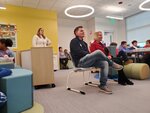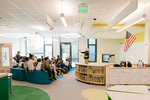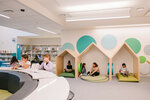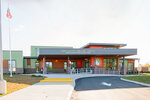Garden City Elementary School, Cranston’s new vision of elementary education has concluded its first trimester. From fifty-year-old buildings, students and teachers alike have transitioned to a …
This item is available in full to subscribers.
We have recently launched a new and improved website. To continue reading, you will need to either log into your subscriber account, or purchase a new subscription.
If you are a current print subscriber, you can set up a free website account by clicking here.
Otherwise, click here to view your options for subscribing.
Please log in to continue |
|






Garden City Elementary School, Cranston’s new vision of elementary education has concluded its first trimester. From fifty-year-old buildings, students and teachers alike have transitioned to a school built for a twenty-first century primary education. Principal Bryan Byerlee invited the Herald, along with Representative Brandon Potter and Senator Hanna Gallo, to tour the new building during a busy school day in the final weeks of the autumn trimester and see how the community was adjusting.
“It was a big transition from the beginning of the year to now,” Byerlee said. “Teachers basically had to learn to do a lot of things differently. Kids had to adapt to being in a much bigger school than they've ever been used to. But it feels small when they're in their learning communities, because each learning community is like its own little family.”
The new program is based around these learning communities, as Byerlee would go on to explain. A far cry from the rigid homeroom structures most graduates of the American public elementary school are used to, learning communities group multiple classes up into a multi-class, multi-grade cohort. The schools have four communities; two for K-2nd grade, and two for 3rd-5th grade. Though each class still has its own teachers and schedule, the learning community provides flexibility, a shared culture, and an opportunity for students to develop their strengths, and receive extra help when needed.
“So as a fourth grader,” Byerlee explains, “in this learning community with third and fourth and fifth graders, most of my day is spent with a fourth grade teacher, and working with fourth grade peers on fourth grade content. But there are interaction opportunities, like homeroom time coming in, in the morning, going to lunch, where I'm with my community of multi grade peers. It just broadens the connections that I have as a fourth grader, and the opportunities to learn or to be receiving differentiated instruction. So if I'm really strong in math, I might have a chance to work with students that are working at a higher level and a different grade.”
Flexible classrooms
This flexible class structure is facilitated by a flexible classroom structure. Rather than classrooms separated by hallways, in Garden City learning communities, every room is a classroom. Each learning community has a number of rooms and areas all suited for different types of instruction. Small rooms for one-on-one and small group work, more traditional classrooms for quiet work time with enormous windows, and an open area between them filled with a variety of comfortable seating and functional furniture. There are even outdoor classrooms for when the weather is a bit nicer. Almost every flat surface is a whiteboard, and you’re as likely to see kids working through equations right on their table with a dry erase marker as to see them working with pencil and paper. The open section includes as well a large projector where, during the tour, fourth graders presented civics projects they had developed to show the legislators. The classrooms in many ways resemble a modern university building, built to pint-size scale.
During classes the kids are free to sit and work in ways that feel most right for them. They move around, they fidget, they behave in ways that one brought up in the ‘sit still and stay quiet’ school of primary education might identify as not paying attention, until you notice how engaged the kids actually are when they’re allowed the leniency to be comfortable.
Byerlee would go on to explain that the kids and teachers are not only adapted to this new classroom, but they had a hand in its envisaging. Before the new school was constructed, the kids were asked what they wanted in their new communities.
“You often expect if you ask first and second graders, you’d get some crazy kinds of answers, right?” Byerlee said. “Things that you wouldn't necessarily want in a school like ball pits and things like that. But no, they wanted windows. They wanted to see light. They wanted comfortable furniture.”
Educators played a role
The educators as well were involved in the process of developing a school building that actually suited the educators. Each learning community has an office area where teachers can step away, get organized, and work collaboratively to build lessons and projects.
“It's about learning how to use different kinds of spaces,” Byerlee said. “How to design spaces that are more geared towards teaching students in 2023. That's more collaborative, more problem solving oriented. So all those pieces came together to grow our staff to get ready for this.”
The new, de-centralized teaching spaces address a problem teachers in Cranston and everywhere have been finding creative solutions for decades: what do you do when instruction has to stretch beyond the classroom? In the old buildings, options are severely limited.
“I've seen students and teachers go and work in hallways, going to work in coat closets,” Byerlee says. “I've seen students working in a staircase just because it's what we had. Now in our learning communities, we have Learning Commons which are the big pieces in the center that can hold large groups of kids. Or I can do stations, station rotations in those areas and students can move around. I also have regular sized classrooms where I can do more traditional, whole class kind of instruction.”
What may seem experimental in all this is actually the culmination of several years of development, starting well before construction of Garden City began.
“We started with Eden Park, that was our Pathfinder project,” Byerlee said. “So we did that project on a small scale, to really learn how to create this kind of learning environment, and how to teach and learn in that kind of setting, a learning community setting.”
Project based learning a cornerstone
The cornerstone of CPS’s new school is Project Based Learning, or PBL. PBL has been practiced in Cranston Public Schools for several years now, but is being perfected in the new buildings.
“When we were in school, projects kind of came at the end of the unit, and they were a way to wrap up, or summarize what you've learned throughout the weeks leading up to that project, and ended in a product that you showed,” Byerlee said. “Now project based learning is really about teaching standards through a project that's connected to the real world where students are trying to solve a problem or answer a question about a problem in their world, where they hear from experts, they have the task of creating a solution to the problem. And through that process, they're learning the standard that we want to teach them.”
Byerlee gives an example of a recent PBL in which an entire learning community was able to come together for a unique, real-world lesson. “One of our learning communities was working with a local author to learn about writing and what the process of publishing a book was. So she presented to our entire learning community, and then students were able to take those ideas they learned from her and go back to their classrooms and grade levels and work on their writing.”
This anecdote is an apt example of something this new learning environment is meant especially to address, something which the entire state of Rhode Island is looking to redevelop as a way to help kids recover from the developmental ravaging of pandemic isolation: literacy development.
“Our teachers have done a lot of professional development in the science of reading,” Byerlee said. “That's an initiative in the state right now, to make sure all teachers are equipped with science of reading knowledge. And so we've worked on developing our teachers as literacy teachers, and they're really making sure students have explicit instruction in reading. This kind of environment is ideal for, I don't want to say remediating that, but supporting that, because students have more opportunities to interact with greater numbers of kids and greater numbers of teachers. So their social connections have increased in this setting.”
Safety, but not a fortress
Crucial as well to helping Garden City students redevelop their social skills is simply a feeling of safety and security, and there’s no school around more secure than Garden City. The building has multiple entry and exit points, the main entrance being equipped with strong double doors called “man-catchers,” from which one cannot enter all the way through unless one has a keycard. Each learning community as well can only be accessed with a keycard. The building is also equipped with surveillance equipment and force glass all over the building.
Which is not to say the building has the air of a fortress. In fact, inside, it is open, airy, and inviting. The cafeteria in particular is broad and comfortable, with a variety of seating arrangements. It is also remarkably well sound-proofed. One is unlikely to hear so well in a room full of one-hundred children anywhere else in town. This style of dining is being emulated even beyond Garden City.
“Lunchtime is a very anxious thing for some kids, they don't want to eat their lunch in front of people,” Jen Cowart, Communications Director for CPS says. “And so to alleviate some of that anxiety, making these spaces more engaging and less scary, even at the high school level, because even at that level kids, you know, have anxiety about lunchtime.”
Senator Gallo, who in addition to being the vice-chair of the state senate committee of education, has decades of experience working as a speech pathologist in Cranston Public Schools, was delighted by the new building. She thought it was an enormous step forward from the old buildings, many of which are now half a century old.
“I think it is the most impressive space that I have seen,” she said. “I think it's a very respectful environment. When a school is old, and most of our schools are, I believe, 50 years old, or that age range, it felt disrespectful. Then people are not in such a happy place, and they don't feel respected. I feel that as professionals, that you need a professional space to work.”
She spoke too of the simple economic benefits of such a school, such as utilities and making the most of crucial support staff. “If you can have more schools [made] into one larger school, into one community, it's cost efficient,” she said. “It's things that you don't think about, like building aids. They're essential. They're the bones that make all this work. You're using all your employees to the best of their ability.”
Representative Potter was likewise impressed by the building and the impact it was having on kids. He said, “You can see the difference when you visit a facility like this, and you see kids actually thriving, and they're working in these open, collaborative working environments, and you can see them actually paying attention, you can get an idea that that's what it actually takes for students to be able to thrive.”
Byerlee is aware of potential criticisms such a seemingly novel approach to teaching may bring up, but is confident this new way of doing things is well reasoned, structured, and actually suited to the needs of children, unlike some failed experiments of yesteryear.
Choice of space, not open space
“People got a sense that it was kind of an open classroom from the 70’s, where there was just open space, and you were expected to collaborate in that big area,” he said. “And that's not the case at all. It's really about choice of space and flexibility. So we do have larger spaces for multiple classrooms to be able to gather in. And we have medium sized spaces and small sized spaces. So it's really about the teacher being able to select the type of space that best suits the instructional goals for that class period or that day.”
To Byerlee, the evidence is apparent that this new building, and this new way of teaching works. You see it when you watch the kids, and the teachers. “What has gone better than I hoped is the level of collaboration that's developed in the learning communities among teachers and students,” he said. “So when you walk into a learning community, you just feel this sense of, and I keep using the word community, but that's what it is. Students working together, teachers working together. Teachers have gotten acclimated to not just having their 22 students, but they feel like every student in that community is theirs. So if they're passing someone and have a word of encouragement, or they're seeing someone struggle when they pull them into one of their groups, or just pull them aside and talk to them, that sense of community has really grown.”
The lessons being learned in the early days of Garden City are being echoed across the district, and will likely be seen implemented when construction of Gladstone Elementary, which will look much like Garden City, is complete in 2025. By then, the communities at Garden City Elementary will be even more accustomed, and even more adept to their 21st century education.
Comments
No comments on this item Please log in to comment by clicking here